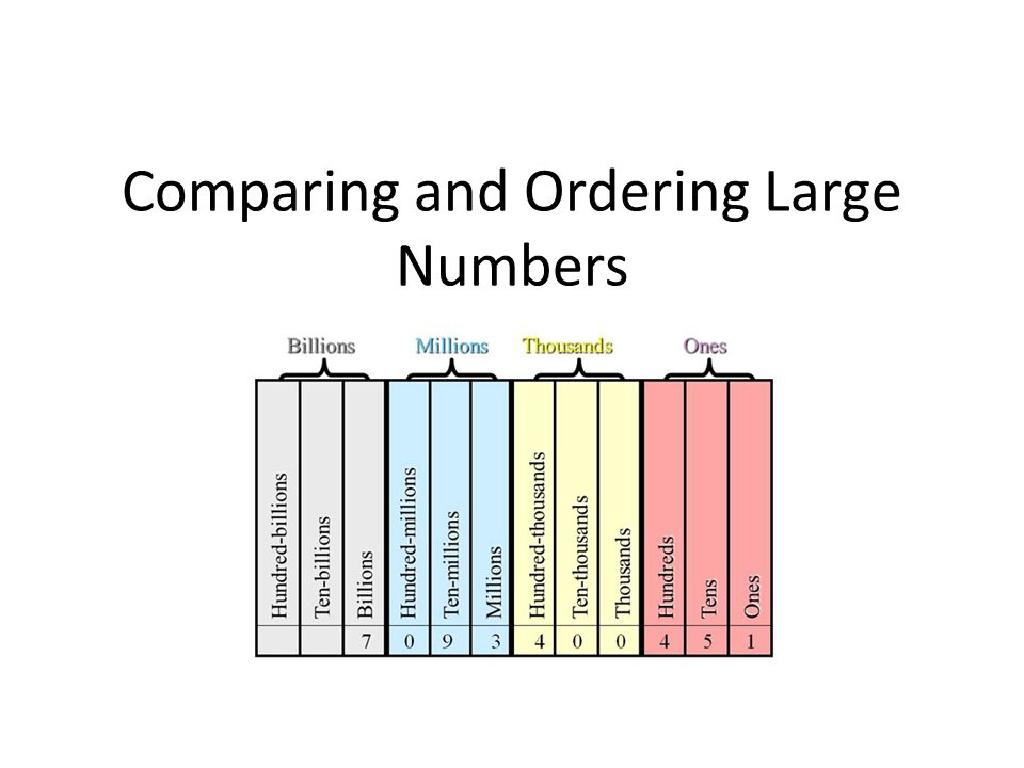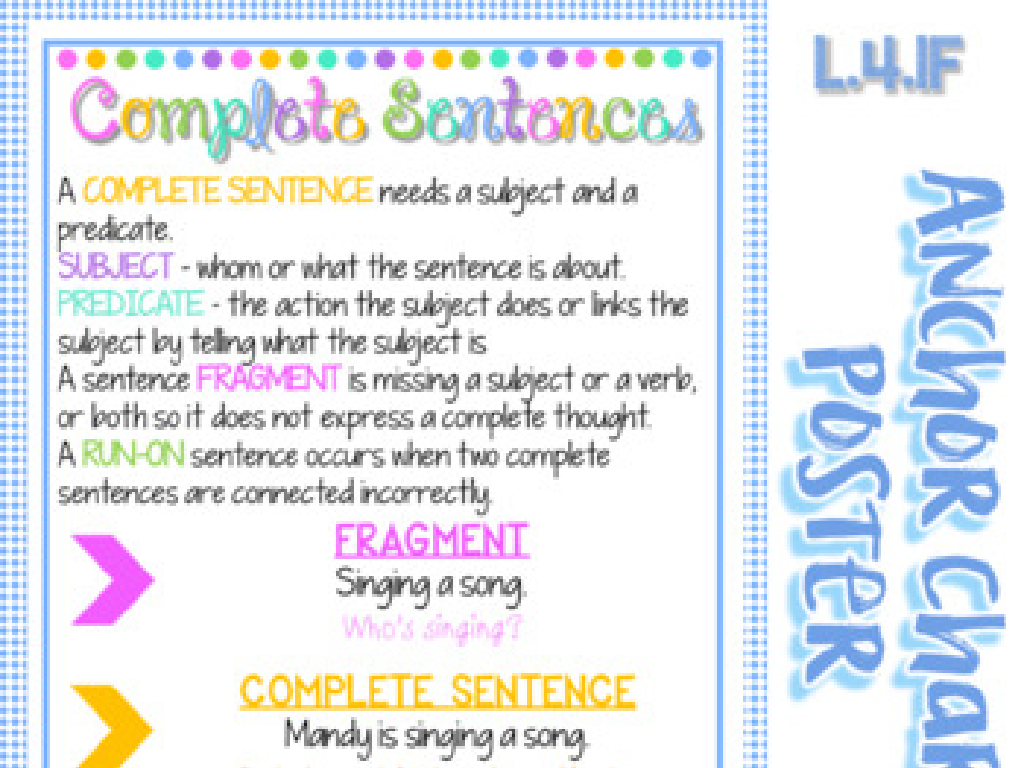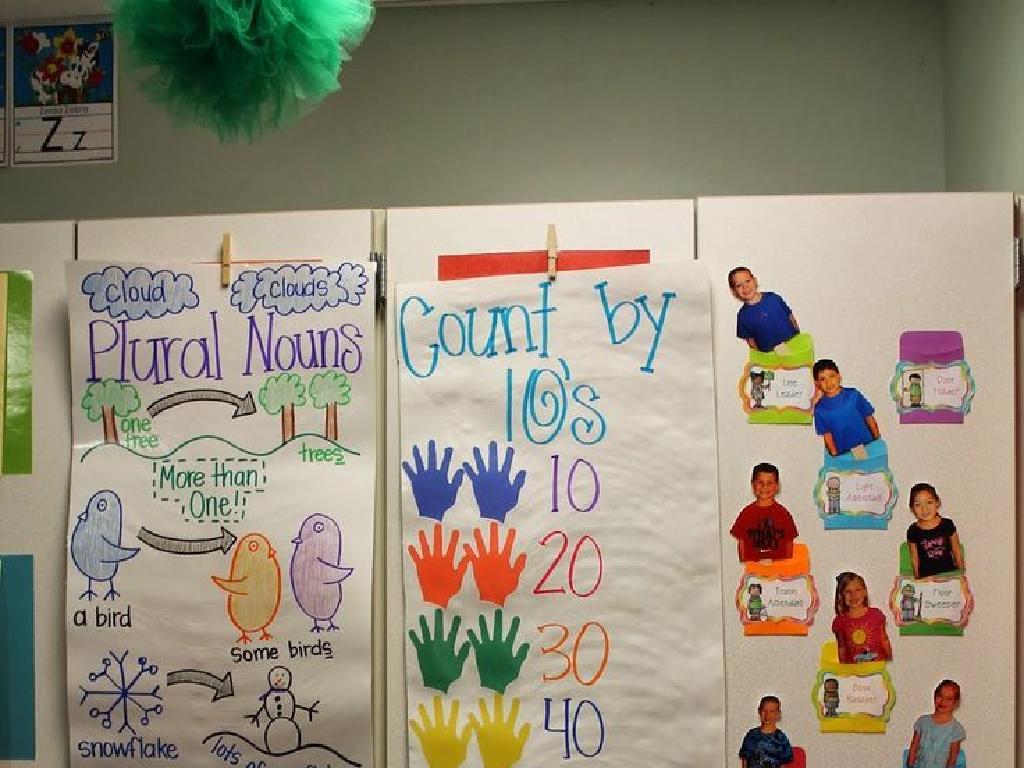Rounding Puzzles
Subject: Math
Grade: Third grade
Topic: Rounding
Please LOG IN to download the presentation. Access is available to registered users only.
View More Content
Today’s Adventure: Rounding Puzzles!
– What is rounding?
– Rounding means finding the nearest ten, hundred, etc.
– Rounding in daily life
– Helps estimate costs and time quickly
– Rounding up and down
– If a number is 5 or more, round up. Less than 5, round down.
– Practice with puzzles
|
Introduce the concept of rounding as a way to simplify numbers to make them easier to work with. Explain that rounding is a practical skill used in everyday situations, such as estimating the total cost while shopping or determining the time needed to travel. Teach the basic rule of rounding: numbers 5 or higher round up to the next ten, while numbers 4 or lower round down. Engage the students with rounding puzzles to apply what they’ve learned. These puzzles will help reinforce their understanding and make the learning process interactive and fun. Prepare a variety of puzzles with different difficulty levels to cater to all students.
What is Rounding?
– Rounding makes numbers simpler
– Keeps value close to the original
– Results are less accurate, easier to use
– Example: 73 rounds to 70
– If you look at the number line, 73 is closer to 70 than to 80
|
Rounding is a fundamental concept in mathematics that simplifies numbers while maintaining a value that is close to the original number. It’s particularly useful for making complex calculations more manageable and for estimating results. When teaching rounding, use a number line to visually demonstrate how numbers are rounded to the nearest ten, hundred, etc. For example, with the number 73, show that it is closer to 70 than to 80 on the number line, hence it rounds down to 70. Emphasize that while the rounded number is not as precise as the original, it is often much easier to work with, especially for mental math or when making quick estimates.
Rounding to the Nearest Ten
– Check the ones place digit
– Is it less than 5 or 5 and above?
– Ones place 5 or more, round up
– 5, 6, 7, 8, or 9 means go to the next ten
– Ones place 4 or less, round down
– 0, 1, 2, 3, or 4 means stay at the current ten
– Example: Rounding 84
– 84 has 4 in the ones place, so it rounds down to 80
|
This slide introduces students to the concept of rounding numbers to the nearest ten. Start by explaining the importance of the ones place in determining how to round a number. Emphasize that if the ones digit is 5 or higher, the number rounds up to the next ten, and if it’s 4 or lower, it stays at the current ten. Use the example of 84 to show that since the ones place is 4, it rounds down to 80. Encourage students to practice with different numbers and to explain their thinking process. This will help solidify their understanding of rounding and prepare them for more complex rounding puzzles.
Rounding to the Nearest Hundred
– Check the tens place digit
– Is it 5, 6, 7, 8, or 9? Go up to the next hundred!
– Tens place 5 or more, round up
– Is it 0, 1, 2, 3, or 4? Stay at the current hundred!
– Tens place 4 or less, round down
– Example: Round 250
– 250 has a 5 in the tens place, so we round up to 300.
|
This slide introduces students to the concept of rounding numbers to the nearest hundred. Start by explaining the importance of the tens place when rounding to hundreds. Use number lines or visual aids to show how numbers with a tens digit of 5 or more will round up to the next hundred, while those with a tens digit of 4 or less will round down. For the example, demonstrate how 250, with a tens digit of 5, rounds up to 300. Encourage students to practice with different numbers and provide immediate feedback. Prepare additional examples and hands-on activities to reinforce the concept.
Let’s Practice Rounding!
– Round 76 to the nearest ten
– Is 76 closer to 70 or 80?
– Round 157 to the nearest hundred
– Is 157 closer to 100 or 200?
– Round 299 to the nearest hundred
– Is 299 closer to 200 or 300?
|
This slide is designed to engage students in a class activity where they practice rounding numbers to the nearest ten and hundred. Start by explaining that rounding helps us to estimate numbers quickly. For 76, guide them to look at the ones place (6) and determine if it’s 5 or above to round up to 80, or less than 5 to round down to 70. For 157 and 299, direct them to look at the tens place to decide whether to round up or down to the nearest hundred. Encourage students to use number lines or rounding charts if they need visual aids. Prepare to offer additional examples if needed and ensure that each student has a chance to participate and demonstrate their understanding.
Rounding Puzzles Adventure
– Solve rounding puzzles
– Find the nearest ten or hundred for each number
– Round numbers on puzzle pieces
– If a piece has 34, does it round to 30 or 40?
– Collaborate to fit pieces
– Team up with classmates to complete the puzzle
– Enjoy the challenge!
|
This slide introduces a fun and interactive class activity focused on rounding numbers. Students will solve puzzles by rounding the numbers on each puzzle piece to the nearest ten or hundred. This activity is designed to reinforce their understanding of rounding concepts in a collaborative and engaging way. Teachers should prepare puzzles with numbers that are appropriate for third-grade students and ensure that each puzzle piece is clearly labeled with a number. During the activity, encourage students to discuss their thought process with their peers and provide assistance as needed. The goal is to create a supportive learning environment where students can apply their rounding skills and enjoy the process of problem-solving together.
Class Activity: Rounding Relay!
– Students form into teams
– Solve puzzles to advance in relay
– Use clues to round numbers correctly
– Each puzzle involves rounding
– Practice rounding to the nearest ten or hundred
– First team to finish wins!
|
This activity is designed to make learning about rounding numbers interactive and fun. Divide the class into small teams, ensuring fair and balanced grouping. Each team will receive a set of puzzles that require them to round numbers to the nearest ten or hundred. As they solve each puzzle, they can move forward in the relay. The puzzles should be age-appropriate and could involve rounding numbers in different contexts, such as prices, distances, or quantities. The first team to correctly complete all their puzzles wins the relay. This activity encourages teamwork, quick thinking, and application of rounding skills. Possible variations of puzzles include rounding up prices in a mock shopping list, estimating distances on a map, or rounding quantities in a recipe. Ensure to walk around and assist teams as needed, providing hints or corrections. Celebrate all participants at the end of the relay to encourage effort and participation.
Rounding Mastery Achieved!
– Congratulations on learning rounding!
– Rounding simplifies numbers
– It helps us estimate and work with numbers quickly
– Keep practicing with puzzles
– The more you practice, the better you’ll get!
– Rounding makes math fun and easy
|
This slide is a celebration of the students’ achievement in learning how to round numbers. It serves as a reminder of the importance of rounding in making calculations easier and quicker. Encourage the students to continue practicing with rounding puzzles, as this will help solidify their understanding and make them more confident in using rounding in different math scenarios. Provide a few examples of rounding puzzles that they can take home, and remind them that learning can be fun when they see how rounding applies to everyday situations like estimating time, money, or measurements.





